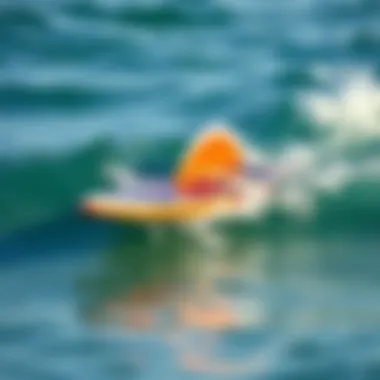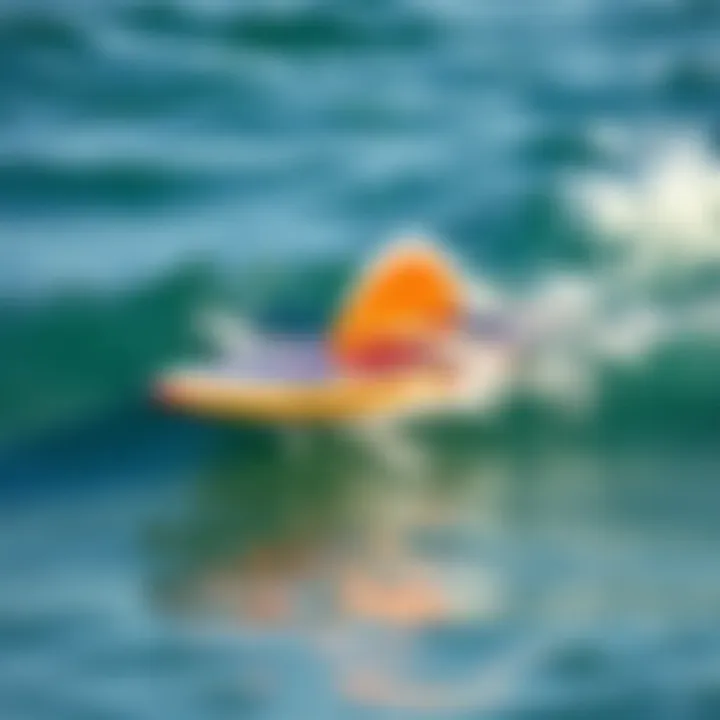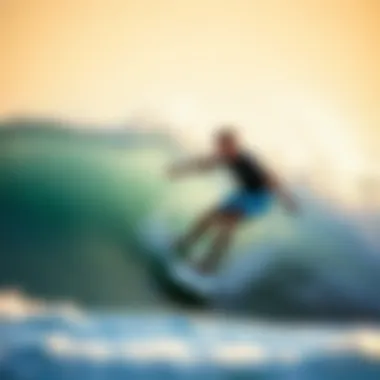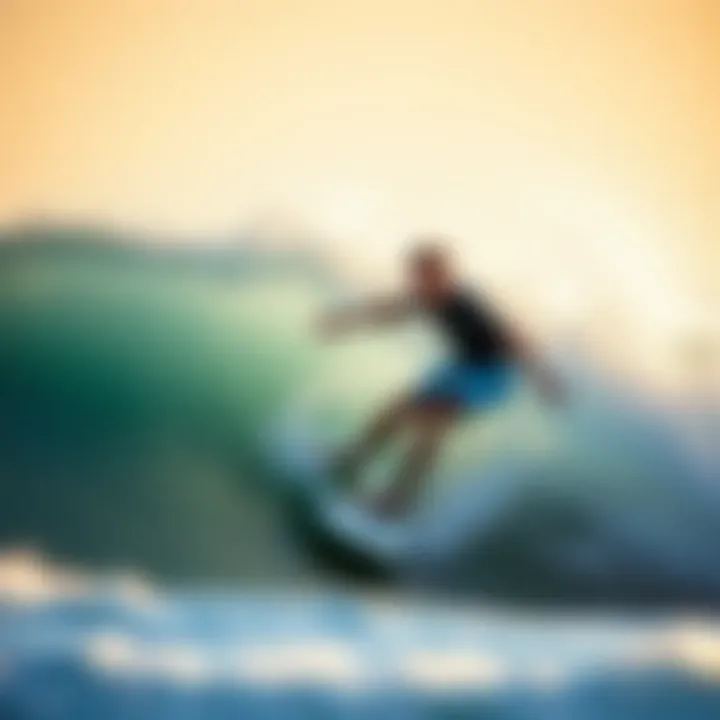Mastering the Fish Board: Techniques and Culture


Intro
Surfing isn't just a sport; it is a way of life, deeply rooted in various cultures and personal stories. Among the kaleidoscope of surfboard designs, the fish board stands out, revered for its unique shape and capacity to thrive in smaller wave conditions. As surfers chase after that perfect wave, understanding the intricacies of fish boards can elevate one’s experience in the ocean. This article will guide you through the landscape of techniques, insights, and the cultural impact surrounding the art of riding a fish board.
In exploring the nuances of this specialty surfboard, we will unravel fundamental aspects like the technologies that shape these boards, delve into optimal riding techniques, and bring light to the cultural reverberations that surround surfing with a fish board. Each section is crafted to provide both novices and seasoned surfers with valuable takeaways, ensuring that you don’t just ride the waves, but understand them. Let's dive in!
Preamble to Fish Boards
The world of surfing evolves constantly, and at the heart of this dynamic activity lies the fish board. Understanding fish boards is crucial for surfers who wish to engage with the nuances of wave riding in smaller conditions. These boards are distinctive not just in shape but in how they perform and interact with the ocean's pulse. It's not merely about balancing on a piece of foam; it’s about harnessing speed and agility where more traditional boards might falter.
Defining the Fish Board
At its core, the fish board is designed for manoeuvrability and speed, especially suited for smaller waves. Characterized by a wider nose and tail, along with a shorter overall length, these boards often have two fins—a design that enhances their ability to carve through the water. Surfing on a fish board provides an exhilarating experience, allowing surfers to draw tighter turns and exploit the power of smaller, rolling waves that might not offer the same joy on longer boards.
One important aspect of fish boards is their adaptability, making them popular among various surfers. Whether a beginner seeking stability or an expert aiming for tricks, the fish board accommodates a wide range of styles. People often say, "it's like riding a skateboard on water," emphasizing how responsive these boards can feel when maneuvering across the surface.
Historical Context and Evolution
The fish board’s journey can be traced back to the 1970s, a time when surfing culture was blossoming and evolving. Originally conceived by surfboard shapers aiming to navigate narrower waves, the fish design came about as a reaction to the increasing need for speed and flexibility. In particular, the Bonzer fish, developed by the Campbell brothers, revolutionized board design, influencing a wave of creativity within the surf community.
Evolutionarily speaking, fish boards were not just a fad; they represented a significant shift in how boards were conceptualized. As surfers began to seek new challenges and tricks, boards like the fish became the tool for expression. Over time, these boards have been further refined with advances in materials and shaping technologies, while still keeping their essence intact. Each iteration brought forth deeper connections between the rider and the ocean, ultimately shaping the surfing culture we know today.
In summary, fish boards are more than just a surfboard type. They embody a chapter in the rich narrative of surfing history, offering something unique to any board enthusiast willing to embrace the ride.
Design Characteristics of Fish Boards
When it comes to surfing, the design of the board plays a crucial role in performance. Fish boards are specifically crafted to optimize surfing within smaller wave conditions. This section unpacks the defining elements of fish board design and why they matter.
Shape and Dimensions
A fish board's shape is one of its most distinctive characteristics. Typically, they feature a wider nose and a swallowtail, which aids in both stability and maneuverability. The dimensions often range from about 5'0" to 6'5", tailored for varying styles and preferences. The shorter length allows for quicker turns, while the wider surface provides extra buoyancy—ideal for thriving in less-than-ideal wave conditions.
- Buoyancy: The unique shape keeps the board afloat, allowing those riding it to catch waves that a regular board might struggle with.
- Turning Dynamics: The swallowtail enables sharper turns, making it easier for surfers to navigate tight spots on a wave.
- Balance: A wider deck assists surfers in maintaining balance while executing tricks or shifting weight.
Choosing the right dimensions matters significantly. For instance, a beginner might opt for a fish board that's a bit longer to gain confidence, while seasoned surfers might prefer a shorter model for agility.
Materials and Construction
Fish boards have come a long way since their early days, evolving in terms of materials and construction methods. Traditional boards were mostly crafted from polyurethane foam and fiberglass. Today, surfers can find boards made from a variety of innovative materials that enhance performance and sustainability.
- EPS Foam: This lightweight material is becoming increasingly popular due to its strength-to-weight ratio, making it easier to paddle and maneuver.
- Epoxy Resin: Known for being lighter than traditional polyester resin, epoxy contributes to the durability of a fish board, allowing it to withstand the wear and tear of regular use.
- Sustainable Alternatives: There’s a growing trend towards eco-friendly boards made from recycled materials, catering to those conscious of their environmental impact.
Surfers looking for new boards should pay attention not just to shape but to how a board is made. Durability can affect performance; a well-constructed board can last for years, making it a better long-term investment.
Comparative Analysis with Other Surfboards
When comparing fish boards with other types of surfboards, like longboards and shortboards, several distinctions arise that showcase the fish board's unique advantages.


- Performance in Small Waves: Fish boards excel in smaller, less powerful surf due to their design, compared to the more buoyant longboards that favor stability.
- Maneuverability: The shorter length and shape of fish boards result in easier turns than shortboards. This allows surfers to enjoy dynamic rides and perform tricks that might be challenging on a conventional board.
- Versatility: While longboards are great for cruising and catching mellow waves, fish boards can transition between a variety of conditions, making them an excellent choice for surfers who frequent different coastal environments.
Surfing Techniques on a Fish Board
When it comes to catching waves on a fish board, mastering specific techniques is crucial for not just enjoying the ride but also for honing skills that elevate any surfer's performance. The unique design and characteristics of fish boards demand distinct approaches to maintain balance, maneuver through turns, and generate speed efficiently. The techniques one learns here can truly make the difference between sliding gracefully over smaller waves or getting tossed around like a ragdoll.
Optimal Stance and Balance
An effective stance often makes or breaks a surf session. For fish board enthusiasts, understanding the optimal stance is about more than just standing upright. The ideal position combines balance and readiness for swift movements. Typically, surfers should adopt a slightly wider stance, adjusting foot placement based on personal comfort and wave size.
- Feet Positioning: Placing your back foot over the tail pad optimizes leverage while your front foot should sit just past the center to create stable hold.
- Knees Bent: A proper knee bend keeps you low to the board. It’s all about absorbing the wave’s energy and maintaining control.
- Engaging Core: A strong core provides stability. Regular practice of core-strengthening exercises off the board can help maintain this balance during rides.
Getting this stance right not only improves your control over the board but also sets you up for a better experience with lateral movements necessary in tight wave conditions.
Turning and Maneuverability
Turning on a fish board isn’t just about leaning; it involves understanding the board's responsiveness. The design of a fish board, which features a wider tail, allows surfers to carve smoothly through turns. It can be said that the magic lies in the subtleties of weight distribution.
- Back Foot Pressure: Applying pressure through your back foot helps pivot the tail around while producing a tighter turn.
- Hip Movement: As you shift your weight, your hips should guide your movements. Rotate your torso towards the integrated line of the turn to ensure a fluid transition.
- Quick Turns: If you’re eyeing a rapid turn, initiate it early and keep your movements sharp and confident.
Surfers accustomed to longer boards may find this challenging at first, but with practice, these adjustments become second nature. Achieving reliable turns lets surfers navigate through smaller waves more effectively, maintaining momentum.
Speed Generation Techniques
Speed on a fish board comes down to mastering certain paddle and riding techniques that play well with the board's naturally buoyant structure. Fish boards thrive in smaller waves, and learning how to generate speed efficiently will enhance the thrill of surfing.
- Paddling Technique: Begin by positioning yourself to catch the wave. Use strong, deliberate strokes while keeping your elbows high to facilitate forward movement without losing energy.
- Pop-up Timing: Timing your pop-up is vital; don’t rush into it. Use the momentum of the wave to aid your pop-up, allowing the flow to send you down the line rather than upwards.
- Trim on the Wave: Once you’re on the wave, position your body for optimal trimming—leaning slightly towards the nose encourages speed. Conversely, if you lean back, it will slow you down.
Learning to harness these speed-generating techniques can make riding a fish board exhilarating. Getting to grips with the dynamics of these movements offers not just a ride but an experience that resonates with the essence of surfing culture.
Cultural Significance of Fish Board Surfing
Understanding the cultural significance of fish board surfing goes beyond mere functionality and performance. This aspect ties closely to how communities perceive surfing as a lifestyle choice and a form of expression. Fish boards, appreciated primarily for their versatility in smaller wave conditions, have forged a unique niche in beach culture. They embody a sense of freedom and adaptability, encouraging surfers to engage with their local environment in a way that resonates deeply with their community values.
Regional Variations in Style
The style of surfing on fish boards often varies dramatically from one region to another. In California, for instance, surf culture is deeply intertwined with the surf industry, leading to a more commercialized approach to fish board design and riding techniques. Surfers here tend to favor short, wide boards that provide quick turns and agility in the crowded beach breaks.
In contrast, surfing communities in places like Indonesia or the Caribbean may approach fish boards from a completely different angle. Here, the boards are often hand-crafted from locally sourced materials, creating a more authentic experience. Surfers often leverage traditional techniques passed down through generations, focusing on the spiritual connection to the ocean and nature. These differences not only reflect the preferences of local surfers but also highlight cultural practices and environmental interactions that shape surfing experiences worldwide.
- California surf culture: commercialized, fast-paced.
- Indo-Carribean: handcrafted boards emphasizing tradition.
The essence of fish board surfing is not just in riding the waves but also in embracing the distinct ethos each community brings to the practice. It's about connecting with the rhythm of the sea and finding a unique identity shaped by the landscapes and traditions of each region.
Fish Boards in Surfing Communities
Fish boards occupy an important place within various surfing communities. They often serve as a catalyst for gatherings, competitions, and bonding experiences among surfers. From local contests showcasing the skills of up-and-coming riders to collaborative beach clean-up events, fish boards can help cultivate a sense of belonging and responsibility among surfers.
Additionally, fish boards have influenced the transition toward a more environmentally conscious approach to surfing. Many communities are making strides in sustainability, driven by the desire to protect the oceans and waves they cherish. The adoption of eco-friendly materials in the construction of fish boards—a response to the growing awareness of the environmental challenges facing our waters—demonstrates the deepening synergy between surfing culture and environmental activism.


"Every time we paddle out, we’re reminded that we are part of something larger than ourselves. Surfing a fish board connects us not just to the waves, but also to each other."
Thus, whether it is the camaraderie developed on a local surf break or the commitment to preserving marine ecosystems, fish boards symbolize a broader narrative of connection—both to the sea and the communities that thrive alongside it.
Choosing the Right Fish Board
Selecting the appropriate fish board can make or break your experience on the waves. It’s not just about grabbing the flashiest board at the surf shop; there’s a level of nuance that needs to be considered. For both seasoned surfers and those just dipping their toes into the water, understanding the types of fish boards available and their unique characteristics can elevate your ride significantly.
When you think about hitting those smaller, punchy waves, choosing the right board lays the groundwork for your comfort and control. Fish boards are specifically designed to perform best under particular conditions; their shapes enhance maneuverability while providing just enough speed. This choice not only impacts your performance but also your enjoyment on the water. Everyone wants to groove with the waves rather than struggle against them, right?
Key Factors to Consider
When you're in the market for a new fish board, there are several factors you must think about:
- Skill Level: Your experience plays a huge role in the right board selection. Beginners might find a more buoyant model easier to balance on, while advanced surfers may prefer a narrower design that offers more precision.
- Wave Conditions: It's essential to reflect on where and when you’ll primarily be surfing. If you’re often in small, surf-friendly spots, a board with extra width and volume will suit you perfectly.
- Weight and Size: Ideally, you want a board that complements your weight. A heavier surfer may benefit from a larger board for more stability, while lighter surfers could choose something slimmer that promotes agility.
- Personal Style: Each surfer develops a unique vibe. Consider how your board’s design and performance affect your style on the waves. A board that aligns with your surf approach makes for a better ride.
"Choosing a surfboard is like picking a dance partner; the right fit allows for rhythm and flow, while the wrong one can lead to stumbling."
Top Brands and Models
Diving deeper into brands can often feel like swimming through a sea of options. However, here are a few notable brands and models that have garnered respect and proven trust among surfers:
- Channel Islands: A go-to for many pro surfers. Their fish boards are renowned for their innovative designs that cater to both beginners and veterans alike.
- Lost Surfboards: Known for the Fish model, it has a reputation for generating speed and performing well in smaller surf conditions.
- Creatures of Leisure: While not as widely recognized for boards, their accessories and board bags are invaluable for maintaining your fish board.
- Firewire: Their eco-friendly boards made from sustainable materials are not only good for the environment but also help maintain peak performance in the water.
- NSP: Offering a wide range of boards in different price points, NSP caters to a variety of surfers, making it a solid choice for those just starting out.
Selecting the right fish board is akin to finding the perfect sneakers for a long run; your experience hinges on that choice. With detailed understanding and clarity about what the ocean throws your way, your time on a fish board can be both thrilling and enjoyable.
Maintenance and Care of Fish Boards
The foundation of any lasting surfboard, especially fish boards, is careful maintenance and care. These boards, designed for agility and speed in smaller waves, require specific attention to keep them in peak condition. Neglect can lead to diminished performance, safety concerns, and a shortened lifespan. This section delves into key practices that enhance the durability and performance of fish boards.
Cleaning and Storage Practices
Keeping a fish board in good shape starts with proper cleaning and storage. After a session in the water, it’s easy to throw your board in a corner and forget about it until the next outing; however, a little diligence goes a long way. Here's how you can maintain your board to ensure it lasts:
- Rinse with Fresh Water: Saltwater can cause damage over time, particularly to the fins and fins’ boxes. Rinsing off your board with fresh water right after surfing helps prevent salt build-up. You wouldn’t want to let the ocean's crust settle on your beloved gear, would you?
- Avoid Direct Sunlight: When drying your board, it’s advisable to place it in the shade. Prolonged exposure to sunlight can weaken the materials and lead to fading, which is all the more relevant for those colorful graphics.
- Proper Storage: When not in use, store the fish board in a bag or a designated spot where it won’t get knocked about. Ideally, store it vertically to avoid pressure on any particular point.
*
"A well-cared fish board isn’t just a tool; it’s an extension of the surfer's art."
*
Having a dedicated space and routine aids in maintaining the overall integrity of your surfboard.
Addressing Common Repairs
Like any piece of equipment, wear and tear can occur. Recognizing potential issues and addressing them promptly is vital. Here are some common repairs and how to handle them:
- Dings and Cracks: Small dings can occur from various incidents—catching a wave at an awkward angle, or even the board scraping against rocks. These can cause water to seep in and lead to more significant problems. Repair kits with resin and patches are available, and they can be applied easily, just follow the instructions on the kit. Just as your buddy knows how to catch a wave, knowing how to patch a ding can be incredibly useful.
- Fin Repairs: Sometimes fins can become loose or damaged. It’s essential to check the fins regularly. If they’re wobbling, tighten them up or replace them if broken. Ensuring the fins are secure will keep your ride smooth and stable.
- Wax Replacement: While not a repair per se, keeping your board waxed is vital. If the grip is fading, it can affect your ability to maneuver effectively. Just reapply wax before you hit the surf again, and you’ll be good as new.


Being proactive about repairs saves costs in the long run and maintains the performance of the fish board. Frequent checks and minor upkeep can keep your board in the best shape possible, enabling you to enjoy every swell to its fullest.
Environmental Impact of Surfboarding
Surfboarding, particularly with fish boards, isn’t just about the thrill of riding waves; it also carries a weighty responsibility regarding environmental preservation. As surf culture propagates globally, the impact on ecosystems becomes a pressing concern. This section focuses on understanding how the surfing community relates to its environment, the negative effects associated with traditional surfboard production, and the movement towards sustainability.
Sustainable Materials
When considering the environmental footprint of surfboards, materials play a pivotal role. Historically, many surfboards have been crafted from polyurethane foam and fiberglass, materials that are not exactly eco-friendly. As surfers become increasingly aware of their ecological impact, many are seeking out alternative materials that reduce harm.
- Epoxy Resins: These are a step forward in terms of sustainability. Unlike traditional polyester resins, epoxy resins are relatively less harmful. They offer greater durability, meaning boards last longer, which ultimately reduces waste.
- Bio-based Foam: Innovations in surfboard manufacturing have lead to the use of bio-based foams, which derive from renewable resources. This means less reliance on fossil fuels and a lower carbon footprint.
- Recycled Materials: Some brands have started creating boards from recycled materials, effectively marrying innovation with ecological responsibility. This not only minimizes waste but also promotes a circular economy within the surf community.
By opting for these sustainable materials, surfers can help foster positive environmental change. Making conscious choices in board selection contributes to the longevity of our oceans and beaches.
Conservation Efforts in Surfing Communities
Community-driven conservation initiatives are sprouting like wildflowers along coastlines. The connection surfers feel to the ocean pushes many to engage actively in conservation efforts.
One noteworthy example is the Surfrider Foundation. This organization mobilizes surfers to protect ocean waves and beaches from pollution and habitat destruction. Their grassroots campaigns emphasize beach clean-ups, advocacy for clean water, and conservation education—fundamental aspects of maintaining healthy marine ecosystems.
In addition to volunteer efforts, various surf schools and businesses are supporting environmental awareness. Many surf schools now include modules on local ecology in their lessons to inform students about the importance of preserving their surfing playgrounds.
For instance:
- Education Programs: Educators use surfboards as vehicles for teaching about marine life, reef ecosystems and the effects of climate change.
- Local Partnerships: Surf shops often collaborate with local environmental groups to fundraise for initiatives intended to protect coastal areas.
"The ocean doesn’t belong to us; we belong to it."
This sentiment resonates deeply within the surf community and reflects a growing acknowledgment of the need for responsibility in surfing culture.
As more surfers adopt eco-conscious practices and support conservation movements, the collective impact can lead to meaningful change. Those who ride fish boards are not merely embracing a style of surf; they are becoming stewards of oceanic health and sustainability.
For further insights into conservation efforts within surfing communities, you can explore resources at Surfrider Foundation and National Oceanic and Atmospheric Administration.
Ultimately, the fusion of surfing and environmental stewardship exemplifies how passion can fuel protection. Acknowledging the integral relationship between surf culture and the health of the environment is not just a trend; it’s essential for the future of surfing.
The End: The Future of Fish Board Surfing
The evolution of fish board surfing is not merely an adaptation to the whims of the ocean; it signifies a broader cultural shift in the surfing community. As surfers continue to seek new experiences and challenges, fish boards have carved a niche, demonstrating their adaptability and relevance in various surf conditions.
Emerging Trends and Innovations
Looking toward the horizon, several trends and innovations are reshaping the landscape of fish board surfing. The rise of eco-conscious consumers has prompted manufacturers to explore novel materials. For example, boards made with sustainable woods and recycled fiberglass are making strides. This shift is crucial as it reflects a growing awareness of the environmental impact of surfboard production. Surf communities are rallying around these sustainable practices, fostering a culture that values both performance and responsibility.
Technology is also playing an ever-increasing role. From performance tracking apps that help surfers analyze their sessions to boards integrated with smart gadgets for real-time feedback, the landscape is buzzing with possibilities. These innovations encourage surfers to hone their techniques, pushing them beyond their limits.
Moreover, riding styles are diversifying. The traditional wave-riding methods are blending with elements from skateboarding and snowboarding, leading to new maneuvering techniques specific to fish boards. Surfers are experimenting, carving their identities in the water, and shaping the next wave of fish board culture.
Final Thoughts on the Fish Board Experience
Ultimately, the experience of surfing a fish board is an intricate dance between the surfer and the sea. It’s about more than just riding waves; it embodies freedom, creativity, and connection with nature. Every ride on a fish board tells a story—of freshness in every maneuver, of glide and speed that small waves can provide.
In a world that’s constantly changing, staying grounded in the roots of surf culture while adapting to new challenges is essential. Fish boards not only encourage individual expression but also promote community bonds that elevate surfing beyond a sport. As these boards continue to grow in popularity, their legacy will intertwine with the very essence of surfing culture, ensuring a future that values innovation and heritage simultaneously. Surfers, both seasoned and new, should take to the water, embrace the journey of discovery, and let their boards determine the rhythm of their ride.
"Surfing has always been about finding your own path, whether on a wave or in life."
The future is bright for fish board surfboarding; with each new rider, the culture expands, creating room for fresh techniques, unique stories, and lasting memories. The wave is waiting.



